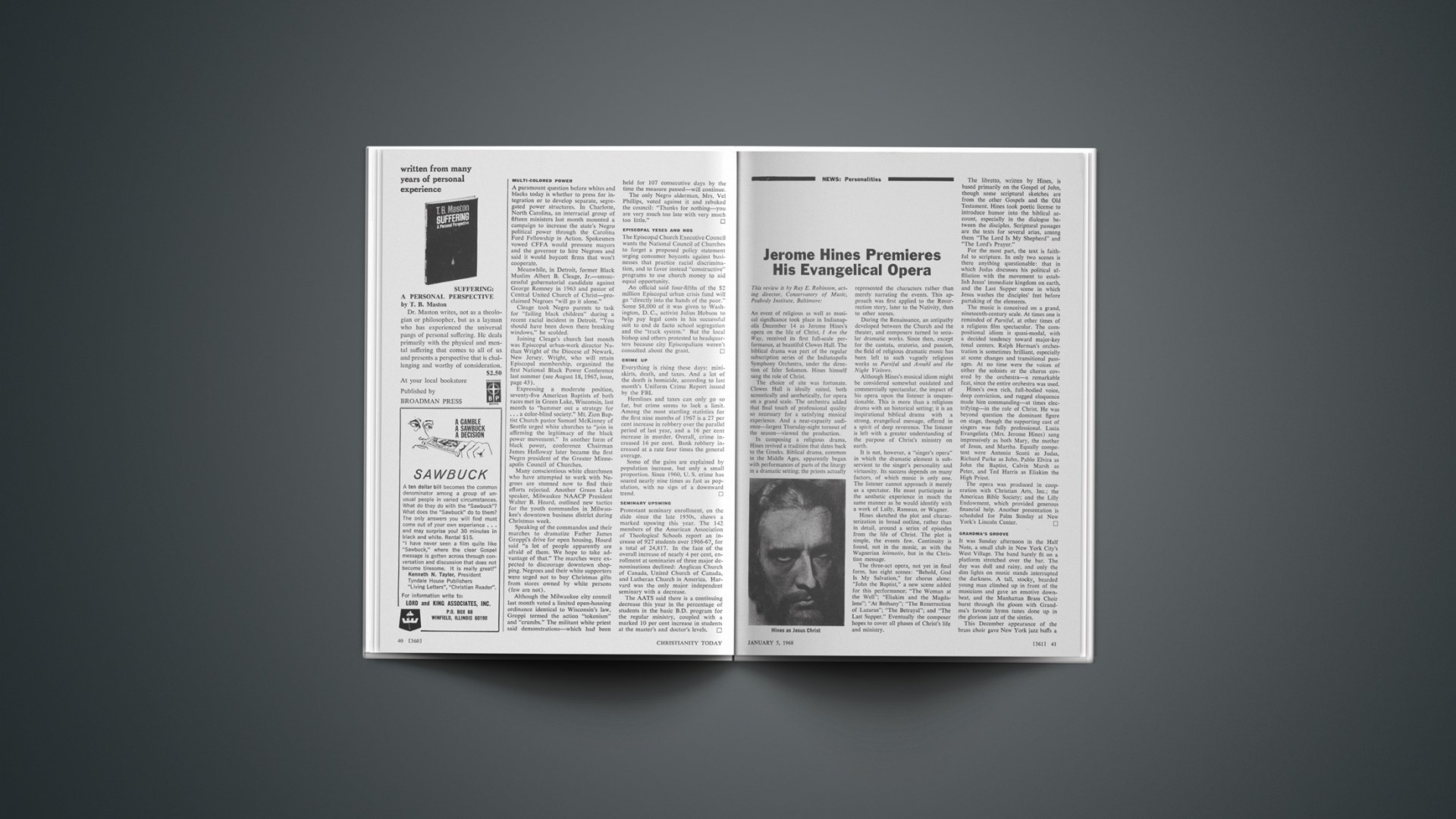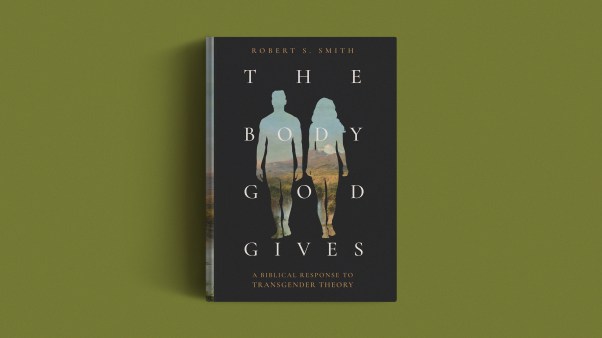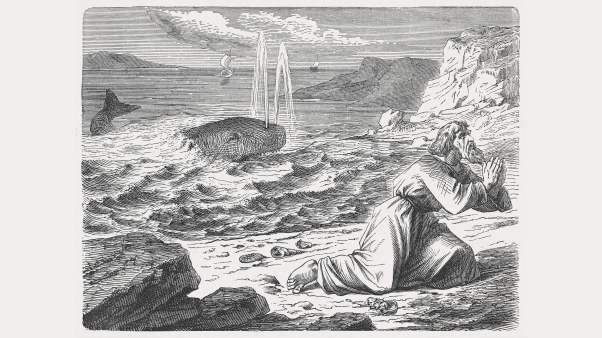This review is by Ray E. Robinson, acting director, Conservatory of Music, Peabody Institute, Baltimore:
An event of religious as well as musical significance took place in Indianapolis December 14 as Jerome Hines’s opera on the life of Christ, I Am the Way, received its first full-scale performance, at beautiful Clowes Hall. The biblical drama was part of the regular subscription series of the Indianapolis Symphony Orchestra, under the direction of Izler Solomon. Hines himself sang the role of Christ.
The choice of site was fortunate. Clowes Hall is ideally suited, both acoustically and aesthetically, for opera on a grand scale. The orchestra added that final touch of professional quality so necessary for a satisfying musical experience. And a near-capacity audience—largest Thursday-night turnout of the season—viewed the production.
In composing a religious drama, Hines revived a tradition that dates back to the Greeks. Biblical drama, common in the Middle Ages, apparently began with performances of parts of the liturgy in a dramatic setting; the priests actually represented the characters rather than merely narrating the events. This approach was first applied to the Resurrection story, later to the Nativity, then to other scenes.
During the Renaissance, an antipathy developed between the Church and the theater, and composers turned to secular dramatic works. Since then, except for the cantata, oratorio, and passion, the field of religious dramatic music has been left to such vaguely religious works as Parsifal and Amahl and the Night Visitors.
Although Hines’s musical idiom might be considered somewhat outdated and commercially spectacular, the impact of his opera upon the listener is unquestionable. This is more than a religious drama with an historical setting; it is an inspirational biblical drama with a strong, evangelical message, offered in a spirit of deep reverence. The listener is left with a greater understanding of the purpose of Christ’s ministry on earth.
It is not, however, a “singer’s opera” in which the dramatic element is subservient to the singer’s personality and virtuosity. Its success depends on many factors, of which music is only one. The listener cannot approach it merely as a spectator. He must participate in the aesthetic experience in much the same manner as he would identify with a work of Lully, Rameau, or Wagner.
Hines sketched the plot and characterization in broad outline, rather than in detail, around a series of episodes from the life of Christ. The plot is simple, the events few. Continuity is found, not in the music, as with the Wagnerian leitmotiv, but in the Christian message.
The three-act opera, not yet in final form, has eight scenes: “Behold, God Is My Salvation,” for chorus alone; “John the Baptist,” a new scene added for this performance; “The Woman at the Well”; “Eliakim and the Magdalene”; “At Bethany”; “The Resurrection of Lazarus”; “The Betrayal”; and “The Last Supper.” Eventually the composer hopes to cover all phases of Christ’s life and ministry.
The libretto, written by Hines, is based primarily on the Gospel of John, though some scriptural sketches are from the other Gospels and the Old Testament. Hines took poetic license to introduce humor into the biblical account, especially in the dialogue between the disciples. Scriptural passages are the texts for several arias, among them “The Lord Is My Shepherd” and “The Lord’s Prayer.”
For the most part, the text is faithful to scripture. In only two scenes is there anything questionable: that in which Judas discusses his political affiliation with the movement to establish Jesus’ immediate kingdom on earth, and the Last Supper scene in which Jesus washes the disciples’ feet before partaking of the elements.
The music is conceived on a grand, nineteenth-century scale. At times one is reminded of Parsifal, at other times of a religious film spectacular. The compositional idiom is quasi-modal, with a decided tendency toward major-key tonal centers. Ralph Herman’s orchestration is sometimes brilliant, especially at scene changes and transitional passages. At no time were the voices of either the soloists or the chorus covered by the orchestra—a remarkable feat, since the entire orchestra was used.
Hines’s own rich, full-bodied voice, deep conviction, and rugged eloquence made him commanding—at times electrifying—in the role of Christ. He was beyond question the dominant figure on stage, though the supporting cast of singers was fully professional. Lucia Evangelista (Mrs. Jerome Hines) sang impressively as both Mary, the mother of Jesus, and Martha. Equally competent were Antonio Scotti as Judas, Richard Parke as John, Pablo Elvira as John the Baptist, Calvin Marsh as Peter, and Ted Harris as Eliakim the High Priest.
The opera was produced in cooperation with Christian Arts, Inc.; the American Bible Society; and the Lilly Endowment, which provided generous financial help. Another presentation is scheduled for Palm Sunday at New York’s Lincoln Center.
GRANDMA’S GROOVE
It was Sunday afternoon in the Half Note, a small club in New York City’s West Village. The band barely fit on a platform stretched over the bar. The day was dull and rainy, and only the dim lights on music stands interrupted the darkness. A tall, stocky, bearded young man climbed up in front of the musicians and gave an emotive down-beat, and the Manhattan Brass Choir burst through the gloom with Grandma’s favorite hymn tunes done up in the glorious jazz of the sixties.
This December appearance of the brass choir gave New York jazz buffs a chance to hear one of the most musically competent religious ensembles that exists today. The group is the child of its soft-spoken conductor, Mark Freeh. He sees it as a natural step in the growth of modern religious music. His musical roots are the Salvation Army’s brass-band program, and his earliest religious training came from his father, a Nazarene clergyman.
Freeh holds that most churches are not progressive enough musically. “The modern man listens to modern music all day long—on TV commercials, on the radio, in movie scores,” he says. He thinks man needs to have religious music speak to him in the same idiom. “We do not go far out,” says Freeh, “but we present music as it is today, by arrangers who are doing today’s television commercials and Broadway scores.”
Freeh likes the gospel tunes of the past. “They are good tunes. They are, if you will, the popular tunes of the Church, even though they are not usually looked at from that perspective.”
The ensemble plays numbers like “In the Sweet By and By” and “Beneath the Cross of Jesus” in arrangements reminiscent of the original intent of the music, but at the same time pleasing to the modern ear. In other selections, taste makes waste.
The choir’s new record album, “Praise to the Living God,” was described by Saturday Review as “startling, without mock piety.” The joy the choir radiates contrasts sharply with the gloom that permeates today’s talk about the death of the Church. “We are not ashamed of the fact that we play only religious music,” says Freeh. “Music that is done well never gets put down.”
The choir, using standard jazz band instrumentation with French horns subbing for saxes, is made up of professional musicians. Says Freeh, “It is only with professionals that we can achieve this degree of musical competence.” Some are regular studio players in New York, others are music teachers, and others are members of the Salvation Army’s New York staff band. All volunteer their services for rehearsal time and some church dates but must receive union scale for recordings and concert performances.
Freeh is organizing college concerts for the spring that will illustrate the history of sacred brass music. Also this year, the group will be heard with Duke Ellington at Carnegie Hall. As Nat Hentoff, New York jazz critic, has said, “Certainly in these arrangements with this choir … the venerable pop tunes of the Church are being reborn and the groove is now.”
JOHN EVENSON
Passing The Pierce Torch
A doctor may well diagnose Bob Pierce’s ailment as a broken heart. For two decades Pierce has criss—crossed the world in behalf of suffering humanity. And always in his suitcase there has been a tattered Bible with these words on the flyleaf:
“Let my heart be broken with the things that break the heart of God.”
Now the strain of setting up orphanages and hospitals, of speeding relief goods to war-ravaged and disaster areas, of organizing pastors’ conferences for discouraged nationals, and of preaching countless evangelistic sermons, has become too much. Pierce, 52, announced last month that, for reasons of health, he has resigned as president of World Vision, Inc., the organization he founded and built into a leading missionary force with an annual budget of more than $6 million.
“Throughout the past four or five years,” he says, “I have had a diminishing amount of time for ministry in the United States. Because of this, and my concern over an apparent decreasing interest here in the total mission of the Church throughout the world, I plan within the bounds of my health to devote a major part of my time to speaking in churches, missionary conventions, colleges, seminaries, and universities in North America.”
More than anyone else since World War II, stocky Robert Willard Pierce has awakened in North American evangelicals a sense of Christian social responsibility. Hundreds of thousands of believers have sent in ten dollars a month to support in Korea or Viet Nam an orphan fathered by an immoral and irresponsible American soldier. The money has come from a well-distributed base of Protestantism, from Presbyterians to Pentecostals—ecumenical in the best sense of the term.
There is great power in Pierce’s compassionate pleas—few can listen without digging into their wallets. But this approach has been a major breakthrough in sophisticated promotion, too. Dramatic films, well-designed advertising, touring orphan choirs, and promises of hand-written letters from orphans have made a big difference. Here and there evangelicals have grumbled over Pierce’s projection of his own personal image. But few realize that he bears the responsibility as well as the glory, and that the material reward is minimal. On the other hand, he has paid the price of being away from his wife and three daughters most of the time.
Pierce was born in Fort Dodge, Iowa, the son of a carpenter who ministered first as a Methodist and then in the Church of the Nazarene. Pierce went to Pasadena College and was ordained in 1942 in the First Baptist Church of Wilmington, California.
After the war he traveled to mainland China in evangelistic work and soon was burdened by the great needs of the Orient. His interest in children began when an infant was thrust into his hands by a distraught missionary who already had too many to care for. He became a correspondent, but soon realized he had to be a participant rather than just a chronicler. Today World Vision cares for more than 23,600 orphaned and needy children in nineteen countries. In addition, it has offered a myriad of services to evangelical causes, ranging from a subsidy to Evangelical Press Association to financial help for the Evangelical Foreign Mission Association purchasing agency, which offers consumer goods at discount prices.
Pierce will be succeeded, at least temporarily, by Richard C. Halverson, minister of Fourth Presbyterian Church, Bethesda, Maryland. Halverson, long a World Vision board member and friend of Pierce, has been named acting president.
ONE MAN’S ‘SPECTRUM’
Bob Jones, William Hamilton, Bishop Pike, John Montgomery, and Carl Henry on the same platform? Sure enough.
The “platform” is a 102-page book, Spectrum of Protestant Beliefs, in which each of the five churchmen speaks about a variety of theological and social issues ranging from the Virgin Birth to Viet Nam. The Rev. Robert Campbell, a Roman Catholic priest, edited the book for Milwaukee’s Bruce Company.
“Most Catholics are quite unaware that the significant divisions in Protestantism no longer are along denominational lines, but rather depend on the orientation of the individual in the liberal-conservative spectrum,” Campbell notes. “The average Protestant layman seems not much better informed.”
Jones represents the fundamentalist band of the Protestant spectrum, Hamilton the death-of-God movement, Pike the liberals, Montgomery the confessional position, and Henry the “new” evangelicals.
Campbell said he did not include so-called developmental theology, identified with Martin Marty, Robert McAfee Brown, and Jaroslav Pelikan, because it is “not typical of a large identifiable segment of popular Protestant beliefs and attitudes.”
Jones is straightforward and quotes Scripture extensively. Henry gives the best philosophical rationale for a biblical perspective, and Montgomery proves to be both incisive and entertaining (“Someone has defined sin as the thing that causes us to look up our own name in the telephone directory as soon as it is delivered”). The three agree on the inerrancy of Scripture.
Pike’s opinions are typified by his reply to the question, “What must a man do to be saved?”
Says the controversial Episcopal churchman: “Man is in the process of being saved, that is being made whole, through responding positively to encounters, through not clutching at the idols, and being open to change.”
The one who gains the dubious distinction of having uttered the most intense invective is Hamilton:
“The doctrine of inspiration seems to me to be a dishonest attempt to live the Christian life without risk, and really, a very demonic attempt as well.”
EVANGELIST SIDELINED
Billy Graham has been fighting bugs of one kind or another for much of the last two years. Last month the evangelist’s doctor ordered him to cancel all public appearances for four months because of his slow recovery from pneumonia.
The major canceled engagement is the series of March and April meetings in New Zealand and Australia. Planners are hopeful Graham can handle the closing meetings the last week of April at the Sydney Showgrounds. The other city committees must decide between going ahead as planned with a Graham associate, or having Graham himself come in 1969 or 1970. Graham is still planning on three American crusades later in 1968.
After he was hospitalized during a team meeting November 26, Graham went to Jamaica for rest and treatment. He returned to his North Carolina home in time for Christmas.
FALLOUT ON THE RIGHT
The American Council of Christian Churches meeting in Santa Monica, California, bristled with the usual complaints about other conservative Protestants such as the Southern Baptist Convention, the Conservative Baptist Association, the Baptist General Conference, and “new evangelicals” generally.
But now the list includes Billy James Hargis, who’s a right-wing broadcaster just like ACCC founder Carl McIntire. A unanimous ACCC resolution attacks Hargis’s drive to get radio listeners to join his temple in Tulsa. Says the ACCC, “Such a ‘paper’ church is both unscriptural and subversive of the separated churches.…”










